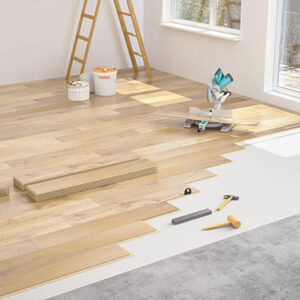Columbus, Ohio remains a very active real estate market, and that activity is sure to accelerate as the pandemic winds down. But since many people will be recovering from its economic impacts for some time to come, the region can probably anticipate especially high demand for less expensive housing in multi-family homes.
These types of properties are a promising investment opportunity, but they present unique challenges when it comes to maintenance and upgrades to infrastructure, including flooring. When choosing a type of flooring for multi-family homes, the property owner needs to measure their own preferences against the likely preferences of individual renters and occupants of adjacent units.
If the owner is confident in their prospective tenants’ responsibility, they may wish to treat those tenants to hardwood floor, and perhaps charge a premium as a result. But there are other risks associated with that choice, apart from the risk of wear-and-tear requiring the owner to replace individual planks or the entire floor in between periods of occupancy.
In multi-family homes, hardwood flooring may also amplify the noise pollution that leaks between units. The same is true, to a greater or lesser extent, of various other options like vinyl and ceramic tiles. Some types of laminate flooring have a built-in solution in the form of a foam backing, but others present the owner with the challenge of adding their own backing, testing the noise-deadening effects of insulation, or simply choosing another, quieter type of flooring.
Noise concerns help contribute to the popularity of carpets in multi-family homes, but of course this type of flooring is also a hassle if there is a high turnover rate among tenants. Minor damage and staining can create significant costs for landlords, who would generally be expected to either replace the carpet entirely or to pay for a thorough, professional cleaning before signing the lease with a new occupant.
Unlike with hardwood and laminate flooring, it’s usually not feasible to remove small pieces of a carpet where it’s been damaged. Also, since transport and installation are more difficult, it’s also not possible for a landlord to remove areas that are in good repair and reuse them in other properties if they decide to sell the first, or to make changes across-the-board.
These various issues frankly lead us to wonder why it isn’t more common to see multi-family homes that have durable and attractive permanent flooring like hardwood or laminate, but come furnished with large area rugs. It seems to us that this setup would provide additional protection against both damage and noise, while also allowing for rugs to be easily swapped out each time a tenant moves.
We recognize that that’s just one of many possible solutions to the challenges associated with installing flooring in multi-family homes. And we wouldn’t try to influence our customers into choosing any particular option. But we’re more than happy to discuss the pros and cons of hardwood, carpeting, rugs, and more, so you can rent out your multi-family homes in complete confidence that the landlord, tenant, and neighbor will all have the best experience they can.
